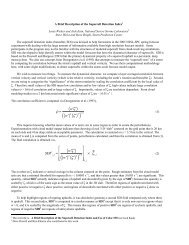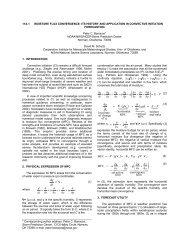Possible Impacts of the Enhanced Fujita Scale on United States ...
Possible Impacts of the Enhanced Fujita Scale on United States ...
Possible Impacts of the Enhanced Fujita Scale on United States ...
Create successful ePaper yourself
Turn your PDF publications into a flip-book with our unique Google optimized e-Paper software.
P8.28 POSSIBLE IMPACTS OF THE ENHANCED FUJITA SCALE<br />
ON UNITED STATES TORNADO DATA<br />
Roger Edwards 1<br />
Storm Predicti<strong>on</strong> Center, Norman, Oklahoma<br />
Harold E. Brooks<br />
Nati<strong>on</strong>al Severe Storms Laboratory, Norman, Oklahoma<br />
1. INTRODUCTION and BACKGROUND<br />
The Nati<strong>on</strong>al Wea<str<strong>on</strong>g>the</str<strong>on</strong>g>r Service (NWS), with<br />
occasi<strong>on</strong>al augmentati<strong>on</strong> by private assessors and<br />
universities, <str<strong>on</strong>g>of</str<strong>on</strong>g>ten uses damage surveys to determine<br />
path characteristics <str<strong>on</strong>g>of</str<strong>on</strong>g> wind events in general and<br />
tornadoes in particular. The results flow into a wide<br />
variety <str<strong>on</strong>g>of</str<strong>on</strong>g> utilizati<strong>on</strong>s, primarily involving:<br />
• Climatological recordkeeping, including <str<strong>on</strong>g>the</str<strong>on</strong>g><br />
county-segmented Storm Data listing and<br />
its whole-tornado “ONETOR” counterpart at<br />
<str<strong>on</strong>g>the</str<strong>on</strong>g> Storm Predicti<strong>on</strong> Center (SPC), as<br />
described in Schaefer and Edwards (1999),<br />
• Applied research <strong>on</strong> severe storms, including<br />
case studies and forensic meteorology,<br />
• Preparedness and hazard-mitigati<strong>on</strong><br />
activities involving <str<strong>on</strong>g>the</str<strong>on</strong>g> NWS, risk-reducti<strong>on</strong><br />
companies in <str<strong>on</strong>g>the</str<strong>on</strong>g> private sector, and all<br />
manner <str<strong>on</strong>g>of</str<strong>on</strong>g> public-sector emergency<br />
management agencies, and,<br />
• Verificati<strong>on</strong> <str<strong>on</strong>g>of</str<strong>on</strong>g> NWS watches and warnings.<br />
For tornadoes, this process began systematically<br />
in <str<strong>on</strong>g>the</str<strong>on</strong>g> 1970s with nati<strong>on</strong>wide NWS use <str<strong>on</strong>g>of</str<strong>on</strong>g> <str<strong>on</strong>g>the</str<strong>on</strong>g> original<br />
<str<strong>on</strong>g>Fujita</str<strong>on</strong>g> (F) tornado damage scale (F <str<strong>on</strong>g>Scale</str<strong>on</strong>g>, <str<strong>on</strong>g>Fujita</str<strong>on</strong>g> 1971,<br />
<str<strong>on</strong>g>Fujita</str<strong>on</strong>g> and Pears<strong>on</strong> 1973). C<strong>on</strong>cerns gradually<br />
developed am<strong>on</strong>g meteorologists and engineers<br />
about <str<strong>on</strong>g>the</str<strong>on</strong>g> inc<strong>on</strong>sistent applicati<strong>on</strong>, subjectivity and<br />
imprecisi<strong>on</strong> <str<strong>on</strong>g>of</str<strong>on</strong>g> <str<strong>on</strong>g>the</str<strong>on</strong>g> F <str<strong>on</strong>g>Scale</str<strong>on</strong>g> (e.g., Minor et al. 1977,<br />
Doswell and Burgess 1988). These issues eventually<br />
motivated <str<strong>on</strong>g>the</str<strong>on</strong>g> collaborati<strong>on</strong> <str<strong>on</strong>g>of</str<strong>on</strong>g> meteorologists and<br />
wind engineers to increase formally <str<strong>on</strong>g>the</str<strong>on</strong>g> number <str<strong>on</strong>g>of</str<strong>on</strong>g><br />
damage indicators (DIs) that could be used to indicate<br />
tornado strength, and enhancing <str<strong>on</strong>g>the</str<strong>on</strong>g> accuracy <str<strong>on</strong>g>of</str<strong>on</strong>g> <str<strong>on</strong>g>the</str<strong>on</strong>g><br />
F <str<strong>on</strong>g>Scale</str<strong>on</strong>g> accordingly. One result was to lower <str<strong>on</strong>g>the</str<strong>on</strong>g><br />
wind speeds resp<strong>on</strong>sible for <str<strong>on</strong>g>the</str<strong>on</strong>g> higher damage<br />
ratings (McD<strong>on</strong>ald et al. 2003), and to calibrate <str<strong>on</strong>g>the</str<strong>on</strong>g><br />
EF and F <str<strong>on</strong>g>Scale</str<strong>on</strong>g>s for climatological c<strong>on</strong>sistency. For<br />
more thorough overviews <str<strong>on</strong>g>of</str<strong>on</strong>g> that process and related<br />
commentaries, refer to Doswell et al. (2009) and<br />
Edwards et al. (2010, this volume).<br />
The NWS <str<strong>on</strong>g>of</str<strong>on</strong>g>ficially began <str<strong>on</strong>g>the</str<strong>on</strong>g> use <str<strong>on</strong>g>of</str<strong>on</strong>g> <str<strong>on</strong>g>the</str<strong>on</strong>g> <str<strong>on</strong>g>Enhanced</str<strong>on</strong>g><br />
<str<strong>on</strong>g>Fujita</str<strong>on</strong>g> <str<strong>on</strong>g>Scale</str<strong>on</strong>g> (EF <str<strong>on</strong>g>Scale</str<strong>on</strong>g>) in February 2007 (LaDue and<br />
Ortega 2008). The <str<strong>on</strong>g>Enhanced</str<strong>on</strong>g> <str<strong>on</strong>g>Fujita</str<strong>on</strong>g> (EF) <str<strong>on</strong>g>Scale</str<strong>on</strong>g><br />
c<strong>on</strong>tains 28 DIs, each <str<strong>on</strong>g>of</str<strong>on</strong>g> which carries degrees <str<strong>on</strong>g>of</str<strong>on</strong>g><br />
damage (DoDs) that indicate a range <str<strong>on</strong>g>of</str<strong>on</strong>g> resp<strong>on</strong>sible<br />
wind speeds (WSEC 2006, Edwards et al. 2010). As<br />
such, <str<strong>on</strong>g>the</str<strong>on</strong>g> EF <str<strong>on</strong>g>Scale</str<strong>on</strong>g> is far more precise and thorough<br />
than <str<strong>on</strong>g>the</str<strong>on</strong>g> F <str<strong>on</strong>g>Scale</str<strong>on</strong>g>. C<strong>on</strong>ceptually <str<strong>on</strong>g>the</str<strong>on</strong>g> EF <str<strong>on</strong>g>Scale</str<strong>on</strong>g> is less<br />
pr<strong>on</strong>e to <str<strong>on</strong>g>the</str<strong>on</strong>g> subjectivity in evaluating wind damage<br />
(<str<strong>on</strong>g>the</str<strong>on</strong>g> F-<str<strong>on</strong>g>Scale</str<strong>on</strong>g> had <strong>on</strong>ly <strong>on</strong>e DI compared to 28 DIs for<br />
<str<strong>on</strong>g>the</str<strong>on</strong>g> EF <str<strong>on</strong>g>Scale</str<strong>on</strong>g>), given <str<strong>on</strong>g>the</str<strong>on</strong>g> sound engineering<br />
foundati<strong>on</strong> for wind speeds assigned to DoDs. Still,<br />
even with <str<strong>on</strong>g>the</str<strong>on</strong>g> use <str<strong>on</strong>g>of</str<strong>on</strong>g> comparative photography that is<br />
embedded in guiding s<str<strong>on</strong>g>of</str<strong>on</strong>g>tware used afield, <str<strong>on</strong>g>the</str<strong>on</strong>g> EF-<br />
<str<strong>on</strong>g>Scale</str<strong>on</strong>g> inherently and unavoidably involves judgment<br />
calls regarding damage levels. Surveying practices<br />
also are undergoing major changes that are expected<br />
to become more prevalent in coming years (Edwards<br />
et al. 2010), including <str<strong>on</strong>g>the</str<strong>on</strong>g> use <str<strong>on</strong>g>of</str<strong>on</strong>g> fine-scale GIS-based<br />
mapping <str<strong>on</strong>g>of</str<strong>on</strong>g> DIs for some events (LaDue and Ortega<br />
2008), with high-resoluti<strong>on</strong> and integrated mapping <str<strong>on</strong>g>of</str<strong>on</strong>g><br />
tornado paths incorporating abundant supporting<br />
documentati<strong>on</strong> in many forms <str<strong>on</strong>g>of</str<strong>on</strong>g> digital metadata.<br />
Despite <str<strong>on</strong>g>the</str<strong>on</strong>g> beneficial intent <str<strong>on</strong>g>of</str<strong>on</strong>g> calibrating <str<strong>on</strong>g>the</str<strong>on</strong>g> F<br />
and EF <str<strong>on</strong>g>Scale</str<strong>on</strong>g>s for <str<strong>on</strong>g>the</str<strong>on</strong>g> sake <str<strong>on</strong>g>of</str<strong>on</strong>g> c<strong>on</strong>tinuity across <str<strong>on</strong>g>the</str<strong>on</strong>g><br />
historic data, all <str<strong>on</strong>g>the</str<strong>on</strong>g>se changes in DIs and surveying<br />
practices hypo<str<strong>on</strong>g>the</str<strong>on</strong>g>tically yield a form <str<strong>on</strong>g>of</str<strong>on</strong>g> “shock”<br />
(Thorne and Vose 2010) to <str<strong>on</strong>g>the</str<strong>on</strong>g> climatological tornado<br />
record. This possibility compels <str<strong>on</strong>g>the</str<strong>on</strong>g> fundamental<br />
questi<strong>on</strong>: “What effect has <str<strong>on</strong>g>the</str<strong>on</strong>g> EF <str<strong>on</strong>g>Scale</str<strong>on</strong>g> had <strong>on</strong><br />
tornado climatology?” The following analyses will<br />
address that questi<strong>on</strong> to <str<strong>on</strong>g>the</str<strong>on</strong>g> greatest extent possible,<br />
given <str<strong>on</strong>g>the</str<strong>on</strong>g> limited time since <str<strong>on</strong>g>the</str<strong>on</strong>g> EF <str<strong>on</strong>g>Scale</str<strong>on</strong>g>’s adopti<strong>on</strong>.<br />
2. ANALYSES and INTERPRETATIONS<br />
a. Basic trends within <str<strong>on</strong>g>the</str<strong>on</strong>g> modernized NWS timeframe<br />
Nati<strong>on</strong>wide deployment <str<strong>on</strong>g>of</str<strong>on</strong>g> <str<strong>on</strong>g>the</str<strong>on</strong>g> WSR-88D radar<br />
network was largely completed in 1995, and this as<br />
associated with <str<strong>on</strong>g>the</str<strong>on</strong>g> dawn <str<strong>on</strong>g>of</str<strong>on</strong>g> <str<strong>on</strong>g>the</str<strong>on</strong>g> “modernized” NWS<br />
era including emphases <strong>on</strong> verificati<strong>on</strong> and reportga<str<strong>on</strong>g>the</str<strong>on</strong>g>ring<br />
practices now in place. Such shifts were<br />
discussed by Verbout et al. (2006), al<strong>on</strong>g with <str<strong>on</strong>g>the</str<strong>on</strong>g><br />
need to use statistical detrending methods when<br />
examining <str<strong>on</strong>g>the</str<strong>on</strong>g> entire tornado record since 1950. In<br />
order to perform some “apples to apples”<br />
1 Corresp<strong>on</strong>ding author address: Roger Edwards, Storm Predicti<strong>on</strong> Center, Nati<strong>on</strong>al Wea<str<strong>on</strong>g>the</str<strong>on</strong>g>r Center, 120 Boren<br />
Blvd #2300, Norman, OK 73072; E-mail: roger.edwards@noaa.gov
Table 1. Absolute numbers <str<strong>on</strong>g>of</str<strong>on</strong>g> tornadoes by time bin (columns) and categories (rows). “Any 3 Avg” c<strong>on</strong>stitutes a sum<br />
<str<strong>on</strong>g>of</str<strong>on</strong>g> <str<strong>on</strong>g>the</str<strong>on</strong>g> entire 15 years divided by 5 to yield an “average 3-year bin.” Red (blue) colored values represent those above<br />
(below) <str<strong>on</strong>g>the</str<strong>on</strong>g> “average 3-year bin” for <str<strong>on</strong>g>the</str<strong>on</strong>g>ir categories. Weak, str<strong>on</strong>g and violent tornado categories represent EF/F0-<br />
1, EF/F2-3, and EF/F4-5 respectively, following comm<strong>on</strong> c<strong>on</strong>venti<strong>on</strong>s in <str<strong>on</strong>g>the</str<strong>on</strong>g> literature dating back to <str<strong>on</strong>g>Fujita</str<strong>on</strong>g> (1976).<br />
Significant tornadoes were rated ≥EF/F2. The EF-<str<strong>on</strong>g>Scale</str<strong>on</strong>g> era is shaded in gray.<br />
COUNTS 2007-2009 2004-2006 2001-2003 1998-2000 1995-1997 Any 3 Avg<br />
EF/F 0 2360 2717 2324 2436 2308 2429<br />
EF/F 1 1145 1106 849 972 878 990<br />
EF/F 2 326 281 256 300 277 288<br />
EF/F 3 96 73 75 106 69 83.8<br />
EF/F 4 15 8 19 21 22 17<br />
EF/F 5 2 0 0 3 2 1.4<br />
Weak 3505 3823 3173 3408 3186 3419<br />
Str<strong>on</strong>g 422 354 331 406 346 372<br />
Violent 17 8 19 24 24 18.4<br />
Significant 439 362 350 430 370 390<br />
EF/F 1 & 2 1471 1387 1105 1272 1155 1278<br />
Total Tors 3944 4185 3523 3838 3556 3809.2<br />
Table 2. As in Table 1, except expressed as percentages <str<strong>on</strong>g>of</str<strong>on</strong>g> <str<strong>on</strong>g>the</str<strong>on</strong>g> total number <str<strong>on</strong>g>of</str<strong>on</strong>g> tornado records in each 3-year bin.<br />
Percentages may not add precisely to 100 due to rounding.<br />
PERCENTS 2007-2009 2004-2006 2001-2003 1998-2000 1995-1997 Any 3 Avg<br />
EF/F 0 59.8 64.9 65.9 63.4 64.9 63.8<br />
EF/F 1 29.0 26.4 24.1 25.3 24.6 26.0<br />
EF/F 2 8.2 6.7 7.2 7.8 7.8 7.6<br />
EF/F 3 2.4 1.7 2.1 2.8 1.9 2.2<br />
EF/F 4 0.4 0.2 0.5 0.5 0.6 0.4<br />
EF/F 5 0.05 0 0 0.08 0.06 0.04<br />
Weak 88.9 91.4 90.0 88.8 89.6 89.8<br />
Str<strong>on</strong>g 10.7 8.5 9.4 10.6 9.7 9.8<br />
Violent .43 .19 .54 .62 .67 .48<br />
Significant 11.1 8.6 9.9 11.2 10.4 10.2<br />
EF/F 1 & 2 37.3 33.1 31.3 33.1 32.4 33.6<br />
Total Tors 100 100 100 100 100 100<br />
comparis<strong>on</strong>s <str<strong>on</strong>g>of</str<strong>on</strong>g> raw trends during this era (e.g.,<br />
without <str<strong>on</strong>g>the</str<strong>on</strong>g> obvious need for detrending), basic<br />
tendencies are examined in <str<strong>on</strong>g>the</str<strong>on</strong>g> nati<strong>on</strong>wide SPC<br />
“ONETOR” data across <str<strong>on</strong>g>the</str<strong>on</strong>g> 1995-2009 time frame,<br />
c<strong>on</strong>taining 19,046 records. The data could be<br />
examined in <str<strong>on</strong>g>the</str<strong>on</strong>g> form <str<strong>on</strong>g>of</str<strong>on</strong>g> five three-year bins, <str<strong>on</strong>g>the</str<strong>on</strong>g> last<br />
covering <str<strong>on</strong>g>the</str<strong>on</strong>g> EF <str<strong>on</strong>g>Scale</str<strong>on</strong>g> era. Because January 2007,<br />
which was <strong>on</strong>e m<strong>on</strong>th prior to <str<strong>on</strong>g>the</str<strong>on</strong>g> implementati<strong>on</strong> <str<strong>on</strong>g>of</str<strong>on</strong>g><br />
<str<strong>on</strong>g>the</str<strong>on</strong>g> EF <str<strong>on</strong>g>Scale</str<strong>on</strong>g>, c<strong>on</strong>tained <strong>on</strong>ly 21 tornado records (out<br />
<str<strong>on</strong>g>of</str<strong>on</strong>g> 1117, or 1.9% <str<strong>on</strong>g>of</str<strong>on</strong>g> <str<strong>on</strong>g>the</str<strong>on</strong>g> yearly total), for temporal<br />
c<strong>on</strong>tinuity <str<strong>on</strong>g>the</str<strong>on</strong>g>y are included with those for <str<strong>on</strong>g>the</str<strong>on</strong>g> rest <str<strong>on</strong>g>of</str<strong>on</strong>g><br />
2007, and for <str<strong>on</strong>g>the</str<strong>on</strong>g> 2007-2009 bin as a whole.<br />
Various absolute tornado totals for <str<strong>on</strong>g>the</str<strong>on</strong>g> entire<br />
period, and for each three-year bin, are shown in<br />
Table 1. Table 2 takes each 3-yearly bin’s c<strong>on</strong>tents<br />
from Table 1 as a percentage <str<strong>on</strong>g>of</str<strong>on</strong>g> total tornadoes in <str<strong>on</strong>g>the</str<strong>on</strong>g><br />
bin, in order to compare relative occurrence <str<strong>on</strong>g>of</str<strong>on</strong>g><br />
different damage classes across bins, and<br />
independently <str<strong>on</strong>g>of</str<strong>on</strong>g> <str<strong>on</strong>g>the</str<strong>on</strong>g> changes in absolute numbers <str<strong>on</strong>g>of</str<strong>on</strong>g><br />
tornadoes from period to period. From <str<strong>on</strong>g>the</str<strong>on</strong>g>se data,<br />
several trends become apparent. The period<br />
c<strong>on</strong>taining <str<strong>on</strong>g>the</str<strong>on</strong>g> most tornadoes, 2004-2006, also<br />
c<strong>on</strong>tained <str<strong>on</strong>g>the</str<strong>on</strong>g> fewest violent tornadoes, nearly an<br />
order <str<strong>on</strong>g>of</str<strong>on</strong>g> magnitude beneath any o<str<strong>on</strong>g>the</str<strong>on</strong>g>r period. Brooks<br />
and Dotzek (2008) discussed <str<strong>on</strong>g>the</str<strong>on</strong>g> complete absence<br />
<str<strong>on</strong>g>of</str<strong>on</strong>g> F5 tornadoes and an apparent increase in <str<strong>on</strong>g>the</str<strong>on</strong>g><br />
number <str<strong>on</strong>g>of</str<strong>on</strong>g> weak tornadoes from 2000-2005 compared<br />
to years prior, trends also evident in our two bins<br />
covering 2001-2006 when compared to earlier bins.<br />
A sharp drop in absolute numbers <str<strong>on</strong>g>of</str<strong>on</strong>g> violent<br />
tornadoes, as well as a more subtle decline in<br />
percentages <str<strong>on</strong>g>of</str<strong>on</strong>g> all tornadoes being violent, also is<br />
evident between 2001 and <str<strong>on</strong>g>the</str<strong>on</strong>g> adopti<strong>on</strong> <str<strong>on</strong>g>of</str<strong>on</strong>g> <str<strong>on</strong>g>the</str<strong>on</strong>g> EF<br />
<str<strong>on</strong>g>Scale</str<strong>on</strong>g> in 2007.<br />
With <str<strong>on</strong>g>the</str<strong>on</strong>g> EF <str<strong>on</strong>g>Scale</str<strong>on</strong>g>, however, <str<strong>on</strong>g>the</str<strong>on</strong>g> patterns found by<br />
Brooks and Dotzek appear to have reversed, in that<br />
EF5 tornadoes have appeared <strong>on</strong>ce again, and <str<strong>on</strong>g>the</str<strong>on</strong>g><br />
number and percentages <str<strong>on</strong>g>of</str<strong>on</strong>g> weak tornadoes has<br />
2
fallen. The number and ratio <str<strong>on</strong>g>of</str<strong>on</strong>g> violent tornadoes also<br />
has increased; however, great cauti<strong>on</strong> should be used<br />
when interpreting violent-tornado trends, given <str<strong>on</strong>g>the</str<strong>on</strong>g><br />
comparatively paltry sample size <str<strong>on</strong>g>of</str<strong>on</strong>g> <str<strong>on</strong>g>the</str<strong>on</strong>g>se events. It<br />
<strong>on</strong>ly can be speculated whe<str<strong>on</strong>g>the</str<strong>on</strong>g>r violent tornadoes<br />
have reappeared in <str<strong>on</strong>g>the</str<strong>on</strong>g> record because <str<strong>on</strong>g>of</str<strong>on</strong>g> damage<br />
rating changes inherent to <str<strong>on</strong>g>the</str<strong>on</strong>g> EF <str<strong>on</strong>g>Scale</str<strong>on</strong>g> 2 , o<str<strong>on</strong>g>the</str<strong>on</strong>g>r n<strong>on</strong>meteorological<br />
aspects <str<strong>on</strong>g>of</str<strong>on</strong>g> <str<strong>on</strong>g>the</str<strong>on</strong>g> rating process,<br />
meteorological chance, and/or <str<strong>on</strong>g>the</str<strong>on</strong>g> spatially<br />
happenstance positi<strong>on</strong>ing <str<strong>on</strong>g>of</str<strong>on</strong>g> EF5-allowing house DIs<br />
in Greensburg, KS (Marshall et al. 2008a) and<br />
Parkersburg, IA (Marshall et al. 2008b) squarely<br />
inside large and violent tornado paths, while tornado<br />
tracks <str<strong>on</strong>g>of</str<strong>on</strong>g> similar geometry fortuitously may have<br />
missed such DIs before.<br />
The most noteworthy change from <str<strong>on</strong>g>the</str<strong>on</strong>g> F <str<strong>on</strong>g>Scale</str<strong>on</strong>g> era<br />
in relative percentages <str<strong>on</strong>g>of</str<strong>on</strong>g> damage ratings may be in<br />
EF1 and EF2 bins, both individually and combined,<br />
seemingly at <str<strong>on</strong>g>the</str<strong>on</strong>g> expense <str<strong>on</strong>g>of</str<strong>on</strong>g> EF0. F1 and F2<br />
tornadoes combined claimed a remarkably steady<br />
porti<strong>on</strong> <str<strong>on</strong>g>of</str<strong>on</strong>g> overall tornado events in each bin prior to<br />
2007, about 31-33%. The EF1+EF2 group jumped to<br />
37.3% <str<strong>on</strong>g>of</str<strong>on</strong>g> tornadoes from 2007-2009, <str<strong>on</strong>g>the</str<strong>on</strong>g> <strong>on</strong>ly <strong>on</strong>e <str<strong>on</strong>g>of</str<strong>on</strong>g><br />
<str<strong>on</strong>g>the</str<strong>on</strong>g> periods above <str<strong>on</strong>g>the</str<strong>on</strong>g> “average 3-year bin” for that<br />
category. Meanwhile, tornadoes rated F/EF0 fell to<br />
<str<strong>on</strong>g>the</str<strong>on</strong>g>ir lowest level in any <str<strong>on</strong>g>of</str<strong>on</strong>g> <str<strong>on</strong>g>the</str<strong>on</strong>g> bins, at ~60%. While<br />
still not definitive, <str<strong>on</strong>g>the</str<strong>on</strong>g> much larger sample sizes <str<strong>on</strong>g>of</str<strong>on</strong>g><br />
<str<strong>on</strong>g>the</str<strong>on</strong>g>se tornado categories more c<strong>on</strong>fidently suggest<br />
that tornado rating practices in <str<strong>on</strong>g>the</str<strong>on</strong>g> EF <str<strong>on</strong>g>Scale</str<strong>on</strong>g> era have<br />
favored EF1-2 events and disfavored EF0s,<br />
compared to <str<strong>on</strong>g>the</str<strong>on</strong>g> rest <str<strong>on</strong>g>of</str<strong>on</strong>g> <str<strong>on</strong>g>the</str<strong>on</strong>g> WSR-88D era. As shown<br />
in Secti<strong>on</strong> 2b, however, <str<strong>on</strong>g>the</str<strong>on</strong>g> evidence for impact <str<strong>on</strong>g>of</str<strong>on</strong>g> <str<strong>on</strong>g>the</str<strong>on</strong>g><br />
EF <str<strong>on</strong>g>Scale</str<strong>on</strong>g> <strong>on</strong> l<strong>on</strong>ger-term tornado climatology is more<br />
nebulous.<br />
b. The EF-<str<strong>on</strong>g>Scale</str<strong>on</strong>g> era in c<strong>on</strong>text <str<strong>on</strong>g>of</str<strong>on</strong>g> multidecadal trends<br />
Brooks and Doswell (2001) discussed <str<strong>on</strong>g>the</str<strong>on</strong>g> relative<br />
c<strong>on</strong>sistency <str<strong>on</strong>g>of</str<strong>on</strong>g> tornado reports by damage scale over<br />
time and in different countries. Some evidence for at<br />
least a general c<strong>on</strong>sistency over that last three<br />
decades can be seen by looking at <str<strong>on</strong>g>the</str<strong>on</strong>g> number <str<strong>on</strong>g>of</str<strong>on</strong>g><br />
tornadoes equal to or exceeding a given damage<br />
threshold during 1980-2009 (Fig. 1). The slopes <str<strong>on</strong>g>of</str<strong>on</strong>g><br />
<str<strong>on</strong>g>the</str<strong>on</strong>g> distributi<strong>on</strong>s for (E)F1+ and greater are at least<br />
somewhat similar. Verbout et al. (2006) provided<br />
evidence that tornadoes prior to 1975 were rated<br />
higher than tornadoes after that and Doswell et al.<br />
(2009) show that ano<str<strong>on</strong>g>the</str<strong>on</strong>g>r lowering <str<strong>on</strong>g>of</str<strong>on</strong>g> assessed<br />
tornado damage occurred in <str<strong>on</strong>g>the</str<strong>on</strong>g> early 2000s.<br />
2 Curiously, <str<strong>on</strong>g>the</str<strong>on</strong>g> appearance <str<strong>on</strong>g>of</str<strong>on</strong>g> any EF5 events<br />
again after a l<strong>on</strong>g absence, and <str<strong>on</strong>g>the</str<strong>on</strong>g> reversal <str<strong>on</strong>g>of</str<strong>on</strong>g> <str<strong>on</strong>g>the</str<strong>on</strong>g><br />
prior violent-tornado decline, seem to c<strong>on</strong>tradict <str<strong>on</strong>g>the</str<strong>on</strong>g><br />
Doswell et al. (2009) noti<strong>on</strong> that “<str<strong>on</strong>g>the</str<strong>on</strong>g> minimum criteria<br />
for producing EF5 damage effectively have been<br />
increased: complete destructi<strong>on</strong> <str<strong>on</strong>g>of</str<strong>on</strong>g> a typical frame<br />
home in <str<strong>on</strong>g>the</str<strong>on</strong>g> USA would no l<strong>on</strong>ger be c<strong>on</strong>sidered<br />
adequate for an EF5 rating and perhaps not even for<br />
EF4.” It remains to be seen whe<str<strong>on</strong>g>the</str<strong>on</strong>g>r <str<strong>on</strong>g>the</str<strong>on</strong>g>se events are<br />
an aberrati<strong>on</strong> or a l<strong>on</strong>ger-term shift.<br />
3<br />
Figure 1: Tornado reports by decade by minimum<br />
damage class, normalized to 500 tornadoes <str<strong>on</strong>g>of</str<strong>on</strong>g> at<br />
least F1 damage (F1+). For comparis<strong>on</strong>, <str<strong>on</strong>g>the</str<strong>on</strong>g> average<br />
number <str<strong>on</strong>g>of</str<strong>on</strong>g> F1 and greater tornadoes per year in 2000-<br />
2009 was 460.<br />
Figure 2: Average number <str<strong>on</strong>g>of</str<strong>on</strong>g> tornadoes <str<strong>on</strong>g>of</str<strong>on</strong>g> at least<br />
F(n+1) damage divided by at least F(n) damage,<br />
averaged over n=1 to 3, by year (black dots) for 1975-<br />
2009. Five-year running value shown by blue line.<br />
One way to look at <str<strong>on</strong>g>the</str<strong>on</strong>g>se changes in detail is to<br />
look at changes in <str<strong>on</strong>g>the</str<strong>on</strong>g> slope <str<strong>on</strong>g>of</str<strong>on</strong>g> <str<strong>on</strong>g>the</str<strong>on</strong>g> line shown in Fig.<br />
1 by fitting a linear regressi<strong>on</strong> through it. Clearly,<br />
including <str<strong>on</strong>g>the</str<strong>on</strong>g> F0 tornadoes (note that for simplicity, we<br />
will refer to all tornadoes as “F” in analyses combining<br />
both scales) provides problems for an analysis going<br />
back even into <str<strong>on</strong>g>the</str<strong>on</strong>g> 80s, in that statistical results can<br />
be dominated by this highly populated damage class.<br />
Similarly, <str<strong>on</strong>g>the</str<strong>on</strong>g> very small sample size <str<strong>on</strong>g>of</str<strong>on</strong>g> F5 tornadoes<br />
does not allow a meaningful statistical analysis to be<br />
performed <strong>on</strong> that damage class. Thus, a linear<br />
regressi<strong>on</strong> line is fit from F1+ through F4+. The slope<br />
can be expressed as <str<strong>on</strong>g>the</str<strong>on</strong>g> number <str<strong>on</strong>g>of</str<strong>on</strong>g> tornadoes at <strong>on</strong>e<br />
class divided by <str<strong>on</strong>g>the</str<strong>on</strong>g> number at <str<strong>on</strong>g>the</str<strong>on</strong>g> previous class.<br />
This can be thought <str<strong>on</strong>g>of</str<strong>on</strong>g> as answering <str<strong>on</strong>g>the</str<strong>on</strong>g> questi<strong>on</strong>,<br />
“Given that a tornado is at least F(n), what’s <str<strong>on</strong>g>the</str<strong>on</strong>g><br />
probability it will be at least F(n+1)?” From 1975-<br />
2009, this overall value was approximately 0.25 (Fig.<br />
2). Beginning in 2000, however, that has been <str<strong>on</strong>g>the</str<strong>on</strong>g><br />
maximum for any year and <str<strong>on</strong>g>the</str<strong>on</strong>g> years 2005, 2006, and<br />
2009 have been lower than any year <strong>on</strong> record back<br />
through 1975. The values in <str<strong>on</strong>g>the</str<strong>on</strong>g> 2000s were lower<br />
than <str<strong>on</strong>g>the</str<strong>on</strong>g> values prior to that at a significance level <str<strong>on</strong>g>of</str<strong>on</strong>g><br />
p=0.05, using a Mann and Whitney (1947) test. The<br />
recent multi-year average has been closer to 0.21.<br />
That implies a reducti<strong>on</strong> <str<strong>on</strong>g>of</str<strong>on</strong>g> F4 and greater tornadoes
y approximately 40% in <str<strong>on</strong>g>the</str<strong>on</strong>g> 2000s. Given <str<strong>on</strong>g>the</str<strong>on</strong>g><br />
relative c<strong>on</strong>sistency in previous years, it seems<br />
unlikely to be <str<strong>on</strong>g>of</str<strong>on</strong>g> meteorological origin.<br />
The EF-scale era is short in durati<strong>on</strong>, but two <str<strong>on</strong>g>of</str<strong>on</strong>g><br />
<str<strong>on</strong>g>the</str<strong>on</strong>g> three years since 2007 provide values closer to<br />
<str<strong>on</strong>g>the</str<strong>on</strong>g> l<strong>on</strong>g term average. Preliminary indicati<strong>on</strong>s are<br />
that 2010 will be as well given that <str<strong>on</strong>g>the</str<strong>on</strong>g>re have been<br />
more EF4 tornadoes this year than in eight <str<strong>on</strong>g>of</str<strong>on</strong>g> <str<strong>on</strong>g>the</str<strong>on</strong>g><br />
years since 2000.<br />
3. CONCLUDING SUMMARY<br />
The change to <str<strong>on</strong>g>the</str<strong>on</strong>g> EF-scale has had an impact <strong>on</strong><br />
damage assessment practices for tornadoes. Those<br />
changes, however, have taken place in a background<br />
<str<strong>on</strong>g>of</str<strong>on</strong>g> relatively large interannual variability in tornado<br />
intensity distributi<strong>on</strong>s. In particular, <str<strong>on</strong>g>the</str<strong>on</strong>g> years just<br />
prior to <str<strong>on</strong>g>the</str<strong>on</strong>g> adopti<strong>on</strong> <str<strong>on</strong>g>of</str<strong>on</strong>g> <str<strong>on</strong>g>the</str<strong>on</strong>g> EF-scale were<br />
characterized by historically low numbers <str<strong>on</strong>g>of</str<strong>on</strong>g> str<strong>on</strong>g<br />
and violent tornadoes, likely as <str<strong>on</strong>g>the</str<strong>on</strong>g> result <str<strong>on</strong>g>of</str<strong>on</strong>g> changes<br />
in subjective assessment practices. As a result, it<br />
appears possible that <str<strong>on</strong>g>the</str<strong>on</strong>g> adopti<strong>on</strong> <str<strong>on</strong>g>of</str<strong>on</strong>g> <str<strong>on</strong>g>the</str<strong>on</strong>g> EF-scale<br />
with its more structured assessment procedures has<br />
led to a slight increase in assessed damage, perhaps<br />
leading to distributi<strong>on</strong>s approaching those seen in <str<strong>on</strong>g>the</str<strong>on</strong>g><br />
1975-1999 era.<br />
ACKNOWLEDGMENTS<br />
The SPC Science Support Branch and Warning<br />
Coordinati<strong>on</strong> Meteorologist Greg Carbin made various<br />
forms <str<strong>on</strong>g>of</str<strong>on</strong>g> data available. NSSL and SPC supported<br />
<str<strong>on</strong>g>the</str<strong>on</strong>g> computati<strong>on</strong>al resources for this work. Steve<br />
Weiss (SPC SOO) provided very helpful review and<br />
suggesti<strong>on</strong>s.<br />
REFERENCES<br />
Brooks, H. E., and C. A. Doswell III, 2001: Some<br />
aspects <str<strong>on</strong>g>of</str<strong>on</strong>g> <str<strong>on</strong>g>the</str<strong>on</strong>g> internati<strong>on</strong>al climatology <str<strong>on</strong>g>of</str<strong>on</strong>g><br />
tornadoes by damage classificati<strong>on</strong>. Atmos. Res.,<br />
56, 191-201.<br />
——, and N. Dotzek, 2008: The spatial distributi<strong>on</strong> <str<strong>on</strong>g>of</str<strong>on</strong>g><br />
severe c<strong>on</strong>vective storms and an analysis <str<strong>on</strong>g>of</str<strong>on</strong>g> <str<strong>on</strong>g>the</str<strong>on</strong>g>ir<br />
secular changes. Climate Extremes and Society,<br />
H.F. Diaz and R. Murnane, Eds., Cambridge Univ.<br />
Press, 35–53.<br />
Doswell, C. A. III, H. E. Brooks, and N. Dotzek, 2009:<br />
On <str<strong>on</strong>g>the</str<strong>on</strong>g> implementati<strong>on</strong> <str<strong>on</strong>g>of</str<strong>on</strong>g> <str<strong>on</strong>g>the</str<strong>on</strong>g> enhanced <str<strong>on</strong>g>Fujita</str<strong>on</strong>g><br />
scale in <str<strong>on</strong>g>the</str<strong>on</strong>g> USA. Atmos. Res., 93, 554–-563.<br />
——, and D. W. Burgess, 1988: On some issues <str<strong>on</strong>g>of</str<strong>on</strong>g><br />
<strong>United</strong> <strong>States</strong> tornado climatology. M<strong>on</strong>. Wea.<br />
Rev., 116, 495-501.<br />
Edwards, R., J. G. LaDue, J. T. Ferree, K.<br />
Scharfenberg, C. Maier, and W. L. Coulbourne,<br />
2010: The <str<strong>on</strong>g>Enhanced</str<strong>on</strong>g> <str<strong>on</strong>g>Fujita</str<strong>on</strong>g> <str<strong>on</strong>g>Scale</str<strong>on</strong>g>: Past, present<br />
and future. Preprints, 25th C<strong>on</strong>f. <strong>on</strong> Severe Local<br />
Storms, Denver, CO, Amer. Meteor. Soc., 4A.1.<br />
SMRP Res. Paper No. 91, Univ. <str<strong>on</strong>g>of</str<strong>on</strong>g> Chicago, 42<br />
pp.<br />
――, 1976: Graphic examples <str<strong>on</strong>g>of</str<strong>on</strong>g> tornadoes. Bull.<br />
Amer. Meteor. Soc., 57, 401-412.<br />
――, and A. D. Pears<strong>on</strong>, 1973: Results <str<strong>on</strong>g>of</str<strong>on</strong>g> F P P<br />
classificati<strong>on</strong> <str<strong>on</strong>g>of</str<strong>on</strong>g> 1971 and 1972 tornadoes.<br />
Preprints, 8th C<strong>on</strong>f. <strong>on</strong> Severe Local Storms,<br />
Denver, CO, Amer. Meteor. Soc., 142–145.<br />
LaDue, J. G., and K. Ortega, 2008: Experiences in<br />
using <str<strong>on</strong>g>the</str<strong>on</strong>g> EF-<str<strong>on</strong>g>Scale</str<strong>on</strong>g> since its incepti<strong>on</strong>. Preprints,<br />
24th C<strong>on</strong>f. <strong>on</strong> Severe Local Storms, Amer. Meteor.<br />
Soc., Savannah, GA, 8B.6.<br />
Mann, H. B., and D. R. Whitney, 1947: On a test <str<strong>on</strong>g>of</str<strong>on</strong>g><br />
whe<str<strong>on</strong>g>the</str<strong>on</strong>g>r <strong>on</strong>e <str<strong>on</strong>g>of</str<strong>on</strong>g> two random variables is<br />
stochastically larger than <str<strong>on</strong>g>the</str<strong>on</strong>g> o<str<strong>on</strong>g>the</str<strong>on</strong>g>r. Annals <str<strong>on</strong>g>of</str<strong>on</strong>g><br />
Ma<str<strong>on</strong>g>the</str<strong>on</strong>g>matical Statistics, 18, 50–60.<br />
Marshall, T. P., D. W. McCarthy, and J. G. LaDue,<br />
2008a: Damage survey <str<strong>on</strong>g>of</str<strong>on</strong>g> <str<strong>on</strong>g>the</str<strong>on</strong>g> Greensburg, KS<br />
tornado. Preprints, 24th C<strong>on</strong>f. <strong>on</strong> Severe Local<br />
Storms, Amer. Meteor. Soc., Savannah, GA, 8B.3.<br />
――, K. A. Jungbluth, and A. Baca, 2008b: The<br />
Parkersburg, IA tornado: 25 May 2008. Preprints,<br />
24th C<strong>on</strong>f. <strong>on</strong> Severe Local Storms, Amer. Meteor.<br />
Soc., Savannah, GA, P3.3.<br />
McD<strong>on</strong>ald, J. R., K. C. Mehta, and S. Mani, 2003: F-<br />
scale modificati<strong>on</strong> process and proposed<br />
revisi<strong>on</strong>s. Preprints, Preprints, Symp. <strong>on</strong> F-<str<strong>on</strong>g>Scale</str<strong>on</strong>g><br />
and Severe-Wea<str<strong>on</strong>g>the</str<strong>on</strong>g>r Damage Assessment, L<strong>on</strong>g<br />
Beach, CA, Amer. Meteor. Soc., P1.1.<br />
Minor, J. E., J. R. McD<strong>on</strong>ald, and K. C. Mehta, 1977:<br />
The tornado: An engineering-oriented perspective.<br />
NOAA Tech. Memo. ERL NSSL-82, 196 pp.<br />
[NTIS PB-281860/AS.]<br />
Schaefer, J. T., and R. Edwards, 1999, The SPC<br />
tornado/severe thunderstorm database. Preprints,<br />
11th C<strong>on</strong>f. <strong>on</strong> Applied Climatology, Dallas, TX,<br />
Amer. Meteor. Soc., 603-606.<br />
Thorne, P. W., and R. S. Vose, 2010: Reanalysis<br />
suitable for characterizing l<strong>on</strong>g-term trends: Are<br />
<str<strong>on</strong>g>the</str<strong>on</strong>g>y really achievable? Bull. Amer. Meteor. Soc.,<br />
91, 353-361.<br />
Verbout, S. M., H. E. Brooks, L. M. Leslie, and D. M.<br />
Schultz, 2006: Evoluti<strong>on</strong> <str<strong>on</strong>g>of</str<strong>on</strong>g> <str<strong>on</strong>g>the</str<strong>on</strong>g> U.S. tornado<br />
database: 1954-2003. Wea. Forecasting, 21, 86-<br />
93.<br />
WSEC, 2006: A recommendati<strong>on</strong> for an enhanced<br />
<str<strong>on</strong>g>Fujita</str<strong>on</strong>g> scale (EF-scale). Wind Science and<br />
Engineering Center, Texas Tech University,<br />
Lubbock, Texas, 95 pp. [Available <strong>on</strong>line at<br />
http://www.depts.ttu.edu/weweb/EF<str<strong>on</strong>g>Scale</str<strong>on</strong>g>.pdf.]<br />
<str<strong>on</strong>g>Fujita</str<strong>on</strong>g>, T. T., 1971: Proposed characterizati<strong>on</strong> <str<strong>on</strong>g>of</str<strong>on</strong>g><br />
tornadoes and hurricanes by area and intensity.<br />
4


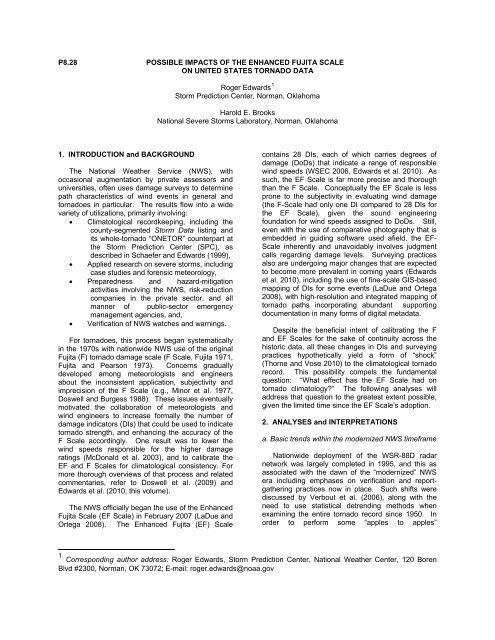
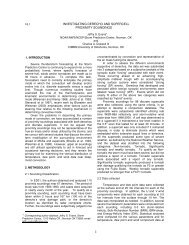
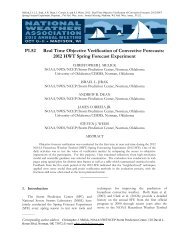
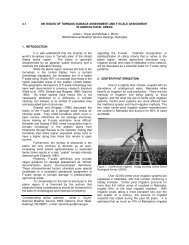
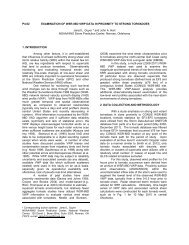
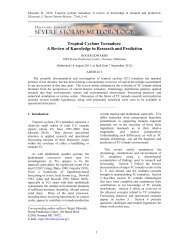

![NSWW_ROC_Overview.ppt [Read-Only] - Storm Prediction Center ...](https://img.yumpu.com/26478320/1/190x146/nsww-roc-overviewppt-read-only-storm-prediction-center-.jpg?quality=85)
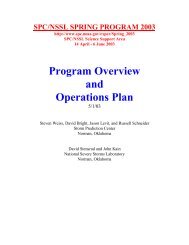
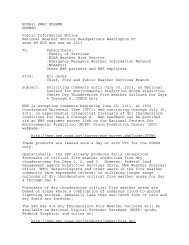
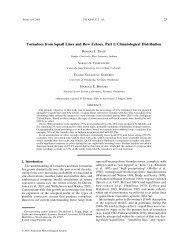

![NEW_PRODUCTS_imy.ppt [Read-Only] - Storm Prediction Center ...](https://img.yumpu.com/26478296/1/190x146/new-products-imyppt-read-only-storm-prediction-center-.jpg?quality=85)
